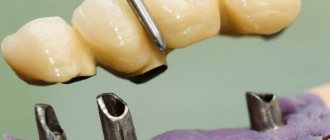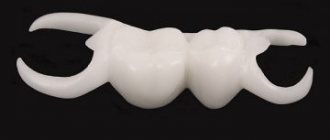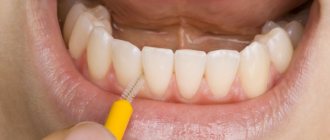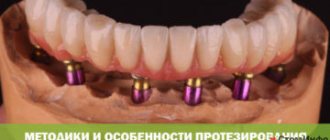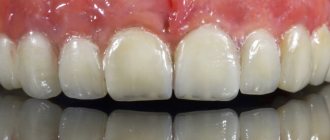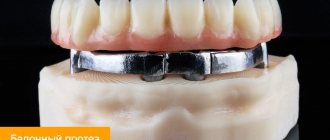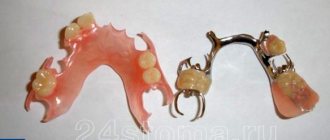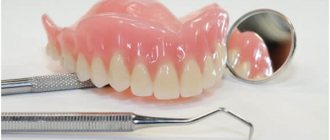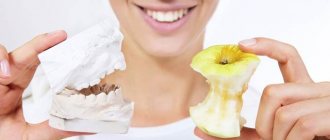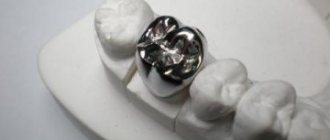When is a removable partial denture placed?
Based on the name, you can understand that a partial removable dental prosthesis imitates a fragment of the dentition. This design can replace several missing teeth in a row or teeth lost in different areas of the jaw. Depending on this factor, the shape and size of the structure itself changes. In general, all types of removable dentures are united by a number of solutions. The base of a partial removable denture imitates soft tissues and part of the palate (if installed on the upper jaw). The boundaries of the prosthesis are clearly defined, since otherwise it would rest on the inner part of the base of the lips and would be unsuitable for wear. Artificial teeth made of plastic are installed in the base, which replace the crown part of missing natural teeth. In general, the design is quite simple, but this is precisely what makes this product so popular and widespread. There are a variety of materials used to make partial dentures, but some of them (for example, plastic) can cause allergic reactions.
Types of partial dentures
Despite the fact that most removable dentures are very similar, experts divide them into several types. The main parameters are the number of teeth to be replaced and the material of manufacture.
Butterfly prosthesis
So named because of its shape, which resembles the wings of a butterfly. In most cases, a butterfly denture is installed when 1–2 teeth are missing in a row.
Partial removable clasp denture
A design that has an all-metal frame. Due to the metal arch, the clasp denture looks compact, but is less aesthetically pleasing than metal-free structures. In addition, metal can cause an allergic reaction.
Partial removable laminar denture
A removable lamellar prosthesis does not contain metal parts (fastening elements can be made of metal) and, in comparison with clasp structures, has a wider soft base.
Partial removable plastic denture
It is the cheapest design, which is often used as a temporary measure (for example, after implantation). A prosthesis made of acrylic plastic has the necessary rigidity, but is less comfortable than softer systems and can cause allergies.
Removable nylon partial dentures
Modern, comfortable and soft nylon prostheses, which, however, are significantly more expensive than plastic structures.
Indications for installation of a removable dental bridge:
- dental defects due to caries, trauma, non-carious lesions (a bridge will increase the risk of re-pathology of hard dental tissues);
- small defects;
- replacement of a low-quality prosthesis installed earlier when its service life has expired;
- cosmetic defects of the dentition (ceramic and metal-ceramic structures are installed).
There are also relative indications: the patient’s age, quality of oral hygiene, general diseases, which may be a contraindication to another option for prosthetics. Old age can be an indication, but only with healthy periodontium.
All-ceramic (ceramic) dental bridges are ideal in terms of aesthetics; they do not change color throughout their lifespan. Ceramic bridges are used for minor defects.
A dental bridge also has a number of disadvantages, including the impossibility of installing a prosthesis if more than 2 teeth are missing in a row. A properly installed bridge with good care can last up to 10 years, but this period often decreases. It is important to choose the right bridge, which is influenced by the bite, the number of missing teeth, financial capabilities and general indications.
The bridge cannot be installed with the following contraindications:
- Teeth grinding or bruxism;
- Pathological bite;
- Periodontal diseases;
- Abrasion of enamel of the chewing group.
Partial removable denture for the upper and lower jaw
If we compare partial and complete removable dentures, then complete structures for the upper and lower jaws have very noticeable differences. For example, in the absence of all the teeth in the lower jaw, the prosthesis, in fact, rests only on the alveolar processes, which cannot be called a reliable fixation. Partial dentures are placed on natural teeth, so there are fewer problems with attachment. The upper partial denture has an artificial palate, which provides additional stability. However, thanks to clasps or attachments, the prosthesis is also very stable.
Bridge structures
A removable dental bridge (nesbit) is a structure made of supporting segments that transmit pressure through attachments or clasps. The undeniable advantage of such a product is the uniform distribution of the chewing load on the teeth and alveolar process, which does not disturb the bite and does not wear off healthy crowns. In addition to everything, a dental bridge is easy to use and provides a good cosmetic effect.
There are the following types of dental bridge:
- ceramic;
- metal-ceramic;
- plastic and metal-plastic;
- solid and adhesive;
- with lock fastening.
Manufacturing of removable dentures
Prosthetics with various types of dentures has been used in clinical practice for decades, so dentistry has a well-functioning production mechanism.
Stages of manufacturing a partial removable denture
- Initial consultation, examination of the oral cavity and selection of orthopedic design.
- Taking impressions and producing a wax model in the laboratory.
- Grinding and correction of the finished structure.
- Finishing the structure in the articulator and trying on the wax structure by the patient.
Although the production of a partial denture takes on average 2 weeks, the adjustment period can last up to a month. At this time, the patient may feel some discomfort, but if the prosthesis causes significant pain and discomfort, it is worth contacting a specialist for correction or replacement of the structure.
Recommendations for quick adaptation
Removable prosthetics will be used in dental practice for a long time due to the reasonable price and speed of production of the product. In addition, most contraindications can be eliminated by providing proper dental care and performing treatment procedures.
When getting used to dentures, there are 3 phases.
Location phase
It is characterized by focusing attention on the orthopedic product, since the structure is perceived as a foreign object. In this case, the patient appears:
- diction defects (a lisp appears);
- excess tension in the cheeks and lips occurs;
- gagging appears.
Partial braking
After a five-day period, tactile sensations return to normal, and almost all negative symptoms are eliminated.
Full braking phase
Its duration ranges from 5 to 33 days. During this period, a person experiences discomfort in the absence of a prosthesis in the oral cavity.
To speed up the adaptation to an orthopedic product, practitioners recommend following the following rules:
- for a two-week period, remove the prosthesis only for hygienic measures;
- to restore diction, it is recommended to read aloud (4 hours daily);
- the first days do not load the front incisors;
- the food should not be rough; the dishes consumed should be cut into small pieces;
- be sure to visit the dentist 3 days after installing the product;
- For better fixation in the mouth, use a fixing cream (Corega, Protefix).
Fixation and stabilization of partial dentures
Methods for fixing partial removable dentures have remained unchanged over the past 10 to 20 years, i.e., since the advent of modern plate dentures.
| Fixation method | Description |
| Clasps | Metal or silicone hooks that fit around natural teeth and secure the denture in the mouth. |
| Attachmen | Micro-locks are installed on the supporting teeth, which snap into place upon contact with the structure. |
| Telescopic crowns | They are considered a very complex structure. The natural tooth is prepared and a special metal cap is put on it, after which a clasp prosthesis with grooves for fastening is installed. |
Pros and cons of partial dentures
Partial dentures have a number of pros and cons. This is an ideal option for temporary prosthetics. However, if implantation is possible, you definitely do not need a removable denture. In any case, it doesn't hurt to know which partial dentures are best. Elastic (but not too soft) designs made from hypoallergenic materials are considered to be of the highest quality. In case of partial absence of teeth, removable laminar dentures made of nylon and acrylic-free plastic are the optimal solution.
- Low price.
- Acceptable functionality and aesthetics.
- Fast production.
- Easy hygiene.
- They do not load the bone, which is why the bone tissue decreases.
- Fragility and fragility (the circuit prosthesis lasts a maximum of 5 years).
- Difficulty getting used to it.
How much do partial dentures cost?
The cost of partial dentures depends on several factors, the main ones being the number of teeth being restored and the material used.
| View | Price |
| Butterfly prosthesis | From 3,000 rubles |
| Plastic partial denture | From 7,000 rubles |
| Clasp prosthesis | From 25,000 rubles (with clasps) From 35,000 rubles (with attachments) From 80,000 rubles (with telescopic crowns) |
| Nylon prosthesis “Quadrotti” | From 37,000 rubles |
| Prosthesis "Acry Free" | From 35,000 rubles |
Clasp prosthesis
Clasp structures are reliable and long-lasting; they distribute pressure on the chewing teeth, bone and supporting crowns.
This design consists of a base, an arc and a retaining element (attachment or clasp).
Indications for clasp prosthetics:
- Missing one anterior crown;
- Pathological abrasion of enamel;
- Loose teeth affecting the bite;
- Double-sided end defect;
- Old age, when a fixed structure is contraindicated;
- Periodontal diseases, periodontal disease with tooth loss.
